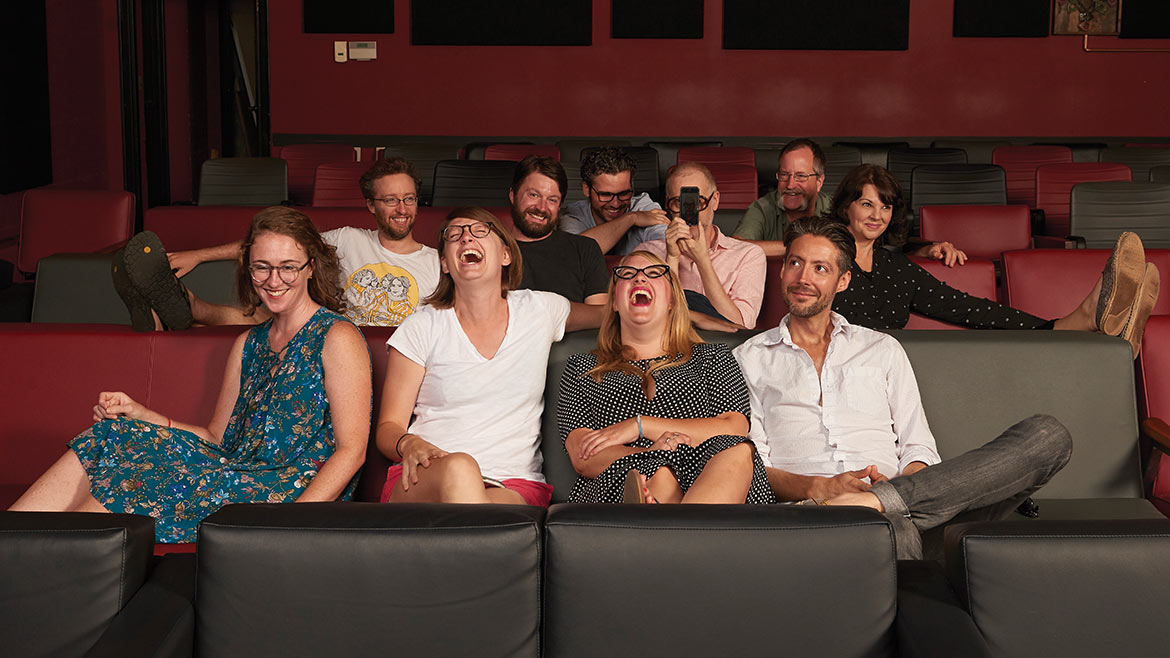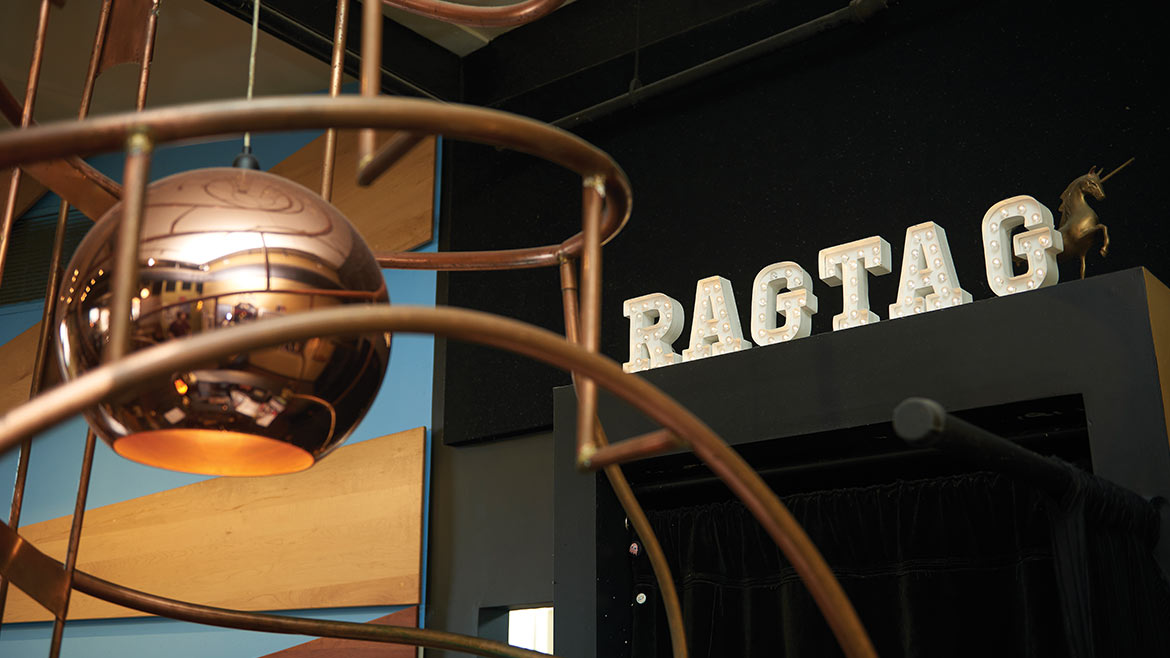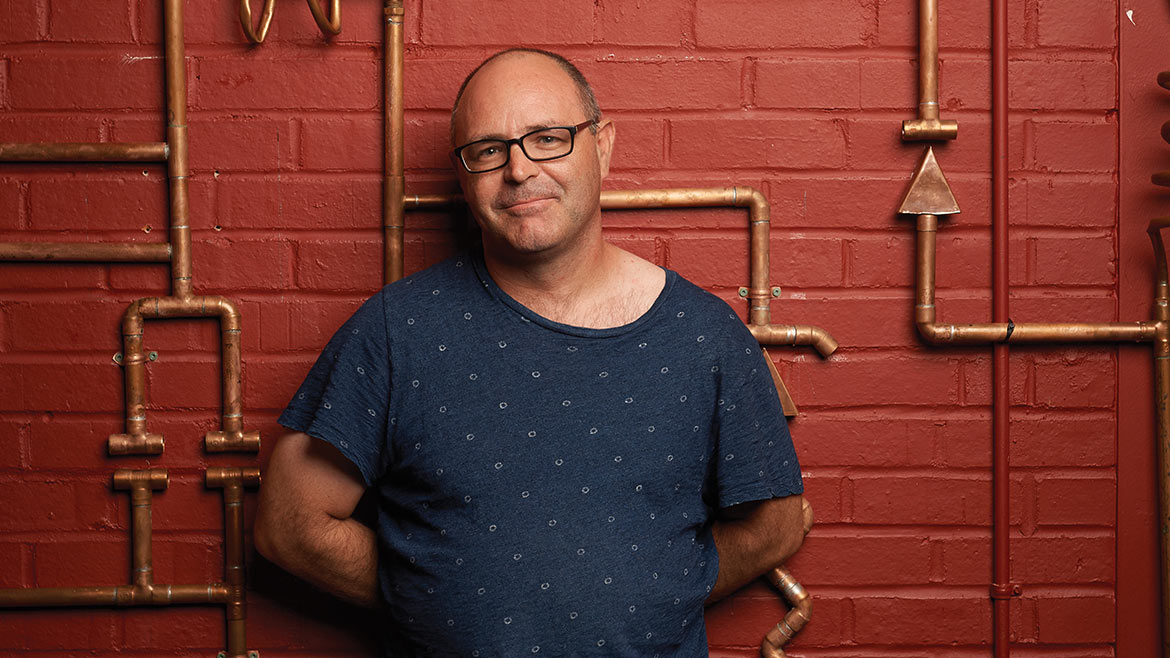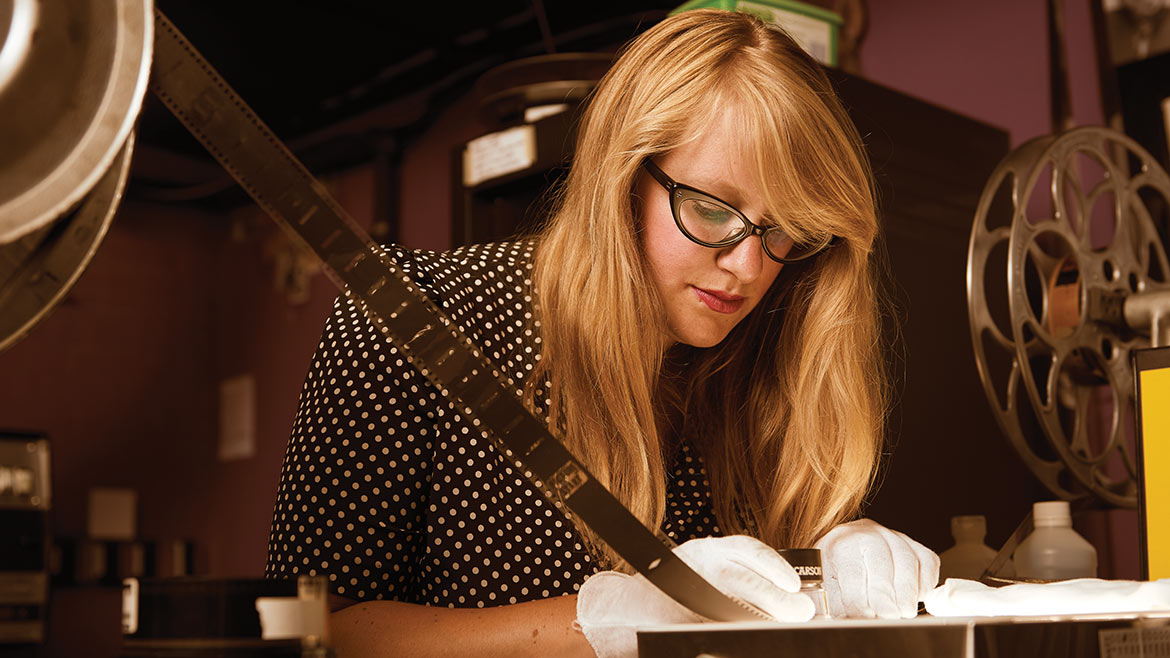Lights, Camera, Ragtag

Why the mischievous champions of independent film want to be way more than Columbia’s coolest movie theater.
It can be hard to get the Ragtag group to focus. While I watched them (try to) pose for a photoshoot, I had flashbacks to feelings I had in grade school at recess, when I’d silently watch the group of kids whom I deeply admired for being cooler than I could ever hope to be.
“Glenn, you’re going to have to pretend to like this.”
“Smile like they just announced that they’re making a third Best Exotic Marigold Hotel.”
“Nagel, get on your phone. You’re always on your phone.”
(At this point, Steve Ruffin, Ragtag’s technical director, pulls up a picture of himself on his phone and starts holding it in front of his face.)
“Think about Nicolas Cage.”
“No!”
“What was that movie where Nicole Kidman had to make out with Nicolas Cage?
Was that ‘Tresspass’?”
“With Nicole Kidman and Nic Cage? Yeah, ‘Trespass’”
“Oh god, can you imagine?”
“How much money did she make to make out with him?”
They begin pulling up pictures of other people on their phones who couldn’t make it to the shoot. Several people in the second and third row of couches try to find an appropriate way to kick their feet up on a seat; in the front row, Lindsay Youngbluth, Callie Lockheart, and Ashley Nagel figure out various ways to cuddle, while Jonny Pez, ankle slung over knee, arms crossed, grins. Tracy Lane, the Ragtag Film Society’s executive director, sits in the back right, smiling at everything.
“You’re not taking notes on this, right?” someone yells at me.
“No, totally unrelated,” I say, pointing at a notepad, ecstatic to be in on the joke.
In 1990, Richard King moved his concert venue, The Blue Note, downtown. An impressive roster of indie rock bands kept coming through to play at King’s venue, to the surprise of a young music journalism student, Tracy Lane. Lane had moved to Columbia from L.A. for school, and she got to know King while waitressing at Boone Tavern, where she worked with King’s girlfriend and future wife, Patty. King would come in to flirt with Patty, and while he was waiting for her, he would talk with Tracy about music.
Tracy was an indie rock fan during what she considers to be the best time to be an indie rock fan, and she cultivated a deep knowledge of the scene that King was attracting to The Blue Note. He offered her a job as an office assistant, and then, in 1991, as general manager. She was 22 years old.
“I feel like I’m one of those people who has always been in the right place at the right time,” Lane says. “I mean, working at The Blue Note in the early ’90s — there couldn’t have been a better time to run an independent music club.”

Lane’s responsibilities at The Blue Note took intense dedication, which seems to come naturally to her. In 1993, while King was away on a golf trip, it snowed nearly two feet in Columbia. The town stopped. No one could get anywhere. A band was scheduled to play that night, and Lane, lacking any connection to the band besides the tour manager’s phone number at The Blue Note, walked from East Campus to her office to call and cancel.
Lane’s tenure at the Blue Note came to an end in late 1995, when Oklahoma City-based psych rock band The Flaming Lips played a show at The Blue Note.
“To cut to the chase,” Lane says, “I fell in love with the tour manager that night. He asked me to marry him that night. He asked me to go on tour with them, and the next morning, I told Richard I was going. That was it. . . Everybody was shocked, because I was really married to my work. My life was completely about the music and the club and making it work.”
Lane’s last night at The Blue Note was New Year’s Eve, 1995. She moved to Oklahoma City, where she and her husband ran a concert production company for three years. Clear Channel, the mass media juggernaut, began competing against them in 1998, at which point Lane and her husband stopped booking shows. “The glory days of the independent music scene were over,” she says. Her husband kept touring; the couple had a daughter, and Tracy happily settled into the role of stay-at-home mom.
Back in Columbia, The Blue Note was still busy.
Few organizations in Columbia are as aptly named as the Ragtag Film Society. In 1997, the “film society” was a group of friends (and “countless disenfranchised Columbia youth,” as Ragtag’s official history notes) who got together at The Blue Note to drink beer and watch whatever good movies they got their hands on. At an early screening of the Japanese fantasy anime film “Princess Monanoke” — the society’s first time using a 35mm projection system — the reels got mixed up. The third and fourth reel were switched, jumping the audience ahead in the narrative. Somebody yelled, “It’s foreshadowing!” and everyone laughed.
Steve Ruffin told me the “Princess Monanoke” story. Ruffin is tall and thin, with gray scruff and thick, round glasses. A lifelong fan of silent films (at age 10, he began ordering copies of obscure films through the mail, shipped from California), he fit the Ragtag scene naturally.

“The atmosphere was very, very easygoing,” Ruffin says. “It was just very nice, enjoyable people who wanted to see the film. A lot of times, you can go to the multiplex and you’re just going to see a film to see a film, to escape, which is great. But those [Ragtag] films weren’t to escape. It was to think about things. It’s about conversation and just — it’s an art form! Sometimes. Sometimes it’s not, and that’s fine and that serves a purpose too, but . . . it was just a really fun atmosphere, I guess.”
The Blue Note screenings quickly attracted enough of a community that a Ragtag storefront became possible. The film society partnered with Bonavita Enterprises to open Ragtag Cinemacafé in 2000, in a building on Tenth Street. Ruffin started working there a while after — he dropped in one day to have a beer and see Tim Spence, who was running the place. Spence looked ragged. Ruffin offered to help out in the kitchen. The next day, Spence offered him a job.
“Especially early on, it was a lot of people just pulling together to get things done,” Ruffin says. “You either knew somebody solid or tangentially, and then you met them when you started to work together.”
In the early 2000s, Ragtag continued building a bigger profile. In 2004, they reconfigured as a nonprofit; that was also the first year of the True/False Film Festival, conceived by original Ragtaggers David Wilson and Paul Sturtz. The festival would go on to arguably become Columbia’s signature cultural event — they sold nearly 50,000 tickets last year — and an inseparable companion to the Ragtag theater. Today, the festival and the theater are split as separate operations within the larger film society, but True/False helped cement Ragtag’s reputation as a cultural institution: Columbia’s home for the art of independent film.
In 2007, three years after True/False’s initial run, Columbia added another festival, the Roots N Blues N BBQ Festival. Richard King, of The Blue Note, took over the festival after a successful first year, and he hired a new director: Tracy Lane, who had moved back to mid-Missouri to raise her daughter in the Columbia arts community. Lane worked at Roots N Blues as its sole paid employee for one year before joining True/False as development director. A year later, after the executive director of Ragtag Film Society had left, she took that job.
Ragtag had since outgrown their Tenth Street home. They raised enough money to move into the old Coca-Cola bottling building on Hitt Street, the building now affectionately nicknamed “Hittsville.”
Ragtag established a permanent home in Hittsville, which they share with Uprise Bakery, which also runs the bar, and Hitt Records, a record store. (Hitt Records originally occupied part of the attic; 9th Street Video, another Hittsville tenant, closed in April and the record store expanded into its space). The three businesses, while separate, share resources in the building, occasionally including employees and volunteers. “We all coexist peacefully,” Lane says. “It’s to our benefit that they’re here, and I think they’d say the same of us.”
The little things make Hittsville feel like a home — the box office, hallways, and both of Ragtag’s theaters are brimming with running gags. A pair of googly eyes moves strategically from movie poster to movie poster (when this story was being written, they were over Viggo Mortenson’s face in the poster for “Captain Fantastic”); paper cutouts of movie characters, like Sally Field in “Hello, My Name is Doris,” peek out from behind frames and edges. The signs for movie showtimes are written in magic marker on printer paper. Even more face cutouts are pasted up against unused projection windows (they can scare the hell out of you if you’re not expecting it). The big theater, though mostly filled with vintage-ish folding theater seats, has a few rows of Ragtag’s signature used couches, donated by a handful of individuals in their 2007-2008 capital campaign. The Willy Wilson Theater, named after local artist and early film society member Willy Wilson, has entirely moveable seating. Wilson passed away in 2013, and the small theater was remade in his memory; local artist Michael Marcum built a sculpture along one wall of the room from copper pipes and trinkets from Wilson’s workshop, including, in a secured box, Wilson’s pipe. On the opposite wall, local artist Jessie Starbuck painted a quote of Wilson’s, “Nothing is impossible; impossible just takes a wee bit longer.”

“I think that Ragtag provides a living room for the community,” says Ann Mehr, a Lee Expressive Arts Elementary School arts teacher and Ragtag fanatic. “We can literally sit on the couches and watch a film. And not only do they have a consistently challenging roster of films, they provide a space to talk about it.”
And talking about art is kind of the point at Ragtag. “I mean, I’ve never had a discussion with people at a megaplex,” Ruffin says. “Everyone just gets up and leaves. Like this, finding others that enjoy something and getting in conversations that push both to go deeper, then maybe you go, ‘Oh, you mentioned that film, we’re going to go find that and maybe watch it together.’”
In their commitment to providing a thought-provoking cinematic experience for all their patrons, Ragtag swims a bit against the 21st century current. Lane estimates that the average Ragtag patron is about 60 years old; her daughter, now 17, is perfectly happy to watch a movie on her cell phone. Ragtag routinely brings in classes of CPS students for movie-watching field trips, and for many of the kids, it’s their first time in a movie theater.
Ragtag is a Partner in Education with Lee, the expressive arts school just a couple blocks away — “They’re the most amazing Partner in Education in the universe,” according to Mehr. Ragtag works with students on different projects, including the field trips and film discussions, but also things like a charming series of stop-motion movies produced by a class of Lee fifth graders.
Ragtag is bolstering their education program, hoping to reach more CPS students and teachers, and thus help create a new generation of consumers who appreciate the art of film. The Media Literacy Initiative, part of a partnership with the CPS Foundation, will “Help young people navigate the massive media landscape in the palm of their hands,” Lane says. “We’ll help them decipher that stuff.”
The CPS Foundation pledged a little over $114,000 to the program over three years. Part of the initiative is a continuation of Ragtag’s existing education activities, like the field trips and film discussions, but it will also put a new focus on training teachers to effectively integrate media in their own classrooms. Ragtag will help teachers develop independent media plans relevant to their curriculum, exposing kids to types of things they might never see otherwise.
I ask Lane if it’s hard to get the kids to see Ragtag’s value. It’s not. “We just bring them in,” she says. “It’s a field trip and your class is going, so you go — but the kids are very happy when they leave.”
“Kids are visual learners,” Mehr says. “One of the things we have to do at Lee is learn how to be a good audience member.” And part of that means actually taking the time to experience a place like Ragtag — a nonprofit, independent movie theater that would spend time and resources showing free movies to kids.
Ragtag’s education initiatives will be crucial to its continued health. They’re recruiting their future supporters. “We have a very loyal community, and without that community, Ragtag wouldn’t exist,” Lane says. “We rely very heavily on donations and memberships that help us reach the larger community.” As Lane and Mehr both point out, children in the community are increasingly growing up oblivious to independent film. Those who do go to movie theaters generally go to big theaters to see big movies. Ragtag won’t survive by drawing huge crowds and making piles of money; they’ll need to get a new generation to realize that their mission is important, if not necessarily profitable.
“The arts are never efficient,” Mehr says. “Life is never efficient.”

Most projection systems today are all-digital, but Ragtag still maintains a pair of old reel systems in addition to their digital set-up. The door leading from the big theater to the projection room is marked off by a sign that says “Non-entry strictly permitted.”
The projection room itself inspires awe with its eccentricity. The door is covered with autographs of various visitors — somewhat mysteriously, someone filled in the space marked off for The Three Stooges. The shelves and surrounding areas are packed with random records, movies, and books (Meat Loaf’s autobiography, “To Hell and Back,” was lying in a conspicuously accessible location), along with other randomness that’s hard to identify. When looking for a photo prop, Ashley Nagel grabs the vinyl edition of the “Apollo 13” soundtrack. Before plopping down in an old armchair, Ruffin grabs an inflatable flotation tube made to look like a tire and slides himself through it. On the room’s desktop computer, Tony Layson pulls up “Charade,” the 1963 Audrey Hepburn film, and freezes it during the scene when Hepburn’s character watches Cary Grant’s character take a shower while fully dressed in a suit. Lots of masks are lying around, including, unsurprisingly, one of the oft mocked Nic Cage.
“Some people have worked here a long time, others have just come through, others come through, and a year or two later, come back,” Ruffin says. “I don’t know, it’s — I don’t want to say a large family, but it’s more like an extended family, in a way.”
Since Lane started working as director, another inconvenient, though somewhat gratifying, challenge has come about — art house films have become popular. Most of the big movie producers now have divisions devoted to the kind of indie films that Ragtag has always shown. Regal Entertainment, the company that owns the Hollywood Theaters on Stadium Boulevard, started buying the same films that Ragtag was trying to buy, giving Lane flashbacks to the days of bidding against Clear Channel in Oklahoma City.
“I think that quite often the distributor, the actual human being that Paul [Sturtz, who still manages Ragtag’s programming] is talking to on the other end of the phone, knows the value of our audience,” Lane says. “They know that, yeah, our auditoriums are smaller and it’s only going to go on one screen, but we’ll promote it and people will see it.” More than once, Lane adds, people have waited for a film to go through its initial run at Regal before seeing it at Ragtag. She doesn’t even see them as serving the same market, really. Big theaters sell people a movie ticket; Ragtag sells an experience.

Since The Blue Note moved downtown in 1990, and since the first True/False Festival in 2004, Ragtag has matured alongside the rest of Columbia’s arts community, which has earned them die-hard loyalty among its members. Between St. Louis and Kansas City, Ragtag is the only theater of its kind. “I consider this place a minor miracle,” Ann Mehr says. “Maybe a major miracle.”
Back in the projection booth, Nagel finds a more elegant photo prop — film. It’s a familiar, translucent swirl of light and dark brown, and seemingly endless. Ruffin hands Nagel a pair of thin white gloves to handle it. They lock the reels into place and loop the film through the projector, delicately, ready to play at any moment.


